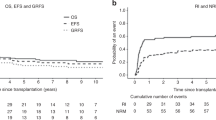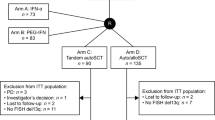Abstract
Immunophenotypic remission (IR) is a strong prognostic factor in myeloma patients. The combination of IR and conventional CR was retrospectively evaluated in 66 patients after allografting. IR was defined as the absence of monoclonal plasma cells in BM aspirates by multiparameter flow cytometry. Conditioning was non-myeloablative in 55 patients; reduced-intensity in 10 and myeloablative in 1 patient. The allograft was given upfront in 35/66 (53%) patients. After a median follow-up of 7.1 years, 24 patients achieved both CR and IR (CR/IR group), 21 achieved IR but not CR with persistence of a urine/serum M-component (no CR/IR group) and 21 did not achieve either CR or IR (no CR/no IR group). Median OS and EFS were 'not reached' and 59 months in the CR/IR group; 64 and 16 months in the no CR/IR; and 36 and 6 months in the no CR/no IR, respectively (P<0.001). Cumulative incidence of extramedullary disease was 4.4% in the CR/IR, 38.1% in the no CR/IR and 14.3% in the no CR/no IR groups, respectively, at 4 years (P<0.001). IR was a valid tool to monitor residual disease after allografting, and allowed definition of a cohort of patients at higher incidence of extramedullary relapse.
This is a preview of subscription content, access via your institution
Access options
Subscribe to this journal
Receive 12 print issues and online access
$259.00 per year
only $21.58 per issue
Buy this article
- Purchase on Springer Link
- Instant access to full article PDF
Prices may be subject to local taxes which are calculated during checkout

Similar content being viewed by others
References
Durie BG, Harousseau JL . International uniform response criteria for multiple myeloma. Leukemia 2006; 20: 1467–1473.
San-Miguel JF, Mateos MV . Can multiple myeloma become a curable disease? Haematologica 2011; 96: 1246–1248.
Stewart AK, Richardson PG, San-Miguel JF . How I treat multiple myeloma in younger patients. Blood 2009; 114: 5436–5443.
Corradini P, Voena C . Molecular and clinical remissions in multiple myeloma: role of autologous and allogeneic transplantation of hematopoietic cells. J Clin Oncol 1999; 17: 208–215.
Martinelli G, Terragna C . Molecular remission after allogeneic or autologous transplantation of hematopoietic stem cells for multiple myeloma. J Clin Oncol 2000; 18: 2273–2281.
Cavo M, Terragna C . Molecular monitoring of minimal residual disease in patients in long-term complete remission after allogeneic stem cell transplantation for multiple myeloma. Blood 2000; 96: 355–357.
Corradini P, Cavo M . Molecular remission after myeloablative allogeneic stem cell transplantation predicts a better relapse-free survival in patients with multiple myeloma. Blood 2003; 102: 1927–1929.
Van Dongen JJ, Lhermitte L . EuroFlow antibody panels for standardized n-dimensional flow cytometric immunophenotyping of normal, reactive and malignant leukocytes. Leukemia 2012 Sep; 26: 1908–1975.
Rawstron AC, Davies FE . Flow cytometric disease monitoring in multiple myeloma: the relationship between normal and neoplastic plasma cells predicts outcome after transplantation. Blood 2002; 100: 3095–3100.
Sarasquete ME, García-Sanz R . Minimal residual disease monitoring in multiple myeloma: a comparison between allelic-specific oligonucleotide real-time quantitative polymerase chain reaction and flow-cytometry. Haematologica 2005; 90: 1365–1372.
Paiva B, Vidriales MB . Multiparameter flow cytometric remission is the most relevant prognostic factor for multiple myeloma patients who undergo autologous stem cell transplantation. Blood 2008; 112: 4017–4023.
Paiva B, Martinez-Lopez J . Comparison of immunofixation, serum free light chain, and immunophenotyping for response evaluation and prognostication in multiple myeloma. J Clin Oncol 2011; 29: 1627–1633.
Rawstron AC, Child JA . Minimal residual disease assessed by multiparameter flow cytometry in multiple myeloma: impact on outcome in the Medical Research Council Myeloma IX Study. J Clin Oncol 2013; 31: 2540–2547.
Bruno B, Rotta M . A comparison of allografting with autografting for newly diagnosed myeloma. N Engl J Med 2007; 356: 1110–1120.
Giaccone L, Storer B . Long-term follow-up of a comparison of nonmyeloablative allografting with autografting for newly diagnosed myeloma. Blood 2011; 117: 6721–6727.
Bruno B, Rotta M . Non-myeloablative allografting for newly diagnosed multiple myeloma: the experience of the Gruppo Italiano Trapianti di Midollo. Blood 2009; 113: 3375–3382.
Rotta M, Storer BE . Long-term outcome of patients with multiple myeloma after autologous hematopoietic cell transplantation and nonmyeloablative allografting. Blood 2009; 113: 3383–3391.
Filipovich AH, Weisdorf D . National Institutes of Health consensus development project on criteria for clinical trials in chronic graft-versus-host disease: I. Diagnosis and staging working group report. Biol Blood Marrow Transplant 2005; 11: 945–956.
Sullivan KM, Agura E . Chronic graft-versus-host disease and other late complications of bone marrow transplantation. Semin Hematol 1991; 28: 250–259.
Bladé J, Samson D . Criteria for evaluating disease response and progression in patients with multiple myeloma treated by high-dose therapy and haemopoietic stem cell transplantation. Myeloma Subcommittee of the EBMT. European Group for Blood and Marrow Transplant. Br J Haematol 1998; 102: 1115–1123.
Bladé J, Fernández de Larrea C, Rosiñol L, Cibeira MT, Jimenez R, Powles R . Soft-Tissue plasmacytomas in multiple myeloma: incidence, mechanisms of extramedullary spread, and treatment approach. J Clin Oncol 2011; 29: 3805–3812.
Moreau P, San Miguel J . Multiple myeloma: clinical practice guidelines for diagnosis, treatment and follow-up. Ann Oncol 2013; 24: vi133–vi137.
Paiva B, Almeida J . Utility of flow-cytometry immunophenotyping in multiple myeloma and other clonal plasma cell-related disorders. Cytometry B Clin Cytom 2010; 78: 239–252.
Avet-Loiseau H, Attal M . Long-term analysis of the IFM 99 trials for myeloma: cytogenetic abnormalities [t(4;14), del(17p), 1q gains] play a major role in defining long-term survival. J Clin Oncol 2012; 30: 1949–1952.
Gray RJ . A class of K-sample tests for comparing the cumulative incidence of a competing risk. Ann Stat 1988; 16: 1141–1154.
Hauwel M, Matthes T . Minimal residual disease monitoring: the new standard for treatment evaluation of haematological malignancies? Swiss Med Wkly 2014; 144: w13907.
Pérez-Simón JA, Sureda A . Reduced-intensity conditioning allogeneic transplantation is associated with a high incidence of extramedullary relapses in multiple myeloma patients. Leukemia 2006; 20: 542–545.
Minnema MC, van de Donk NW . Extramedullary relapses after allogeneic non-myeloablative stem cell transplantation in multiple myeloma patients do not negatively affect treatment outcome. Bone Marrow Transplant 2008; 41: 779–784.
Passera R, Pollichieni S . Allogeneic hematopoietic cell transplantation from unrelated donors in multiple myeloma: study from the Italian Bone Marrow Donor Registry. Biol Blood Marrow Transplant 2013; 19: 940–948.
Kumar SK, Rajkumar SV . Improved survival in multiple myeloma and the impact of novel therapies. Blood 2008; 111: 2516–2520.
Varettoni M, Corso A . Incidence, presenting features and outcomes of extramedullary disease in multiple myeloma: a longitudinal study on 1003 consecutive patients. Ann Oncol 2010; 21: 325–330.
Caers J, Withofs N . The role of positron emission tomography-computed tomography and magnetic resonance imaging in diagnosis and follow up of multiple myeloma. Haematologica 2014; 99: 629–637.
Stawis AN, Maennle D . Recurrent plasmacytomas after allografting in a patient with multiple myeloma. Case Rep Med 2012; 2012: 168785.
Bruno B, Giaccone L . Novel targeted drugs for the treatment of multiple myeloma: from bench to bedside. Leukemia 2005; 19: 1729–1738.
Bruno B, Rotta M . New drugs for treatment of multiple myeloma. Lancet Oncol 2004; 5: 430–442.
Acknowledgements
We thank the patients who participated in this study, all physicians, nurses and support personnel for their care of patients, and Jessica Mastrovito and Maria Josè Fornaro for manuscript preparation, supported in part by Progetti di Ricerca ex-60%, Ministero dell’Università e della Ricerca Scientifica (MIUR); Regione Piemonte: Ricerca Finalizzata 2008, 2009; Fondazione Cassa di Risparmio di Torino (CRT); Compagnia di San Paolo; Comitato Regionale Piemontese Gigi Ghirotti; and Fondazione Neoplasie Sangue Onlus (FONESA).
Author information
Authors and Affiliations
Corresponding author
Ethics declarations
Competing interests
The authors declare no conflicts of interest.
Rights and permissions
About this article
Cite this article
Giaccone, L., Brunello, L., Festuccia, M. et al. Clinical impact of immunophenotypic remission after allogeneic hematopoietic cell transplantation in multiple myeloma. Bone Marrow Transplant 50, 511–516 (2015). https://doi.org/10.1038/bmt.2014.319
Received:
Revised:
Accepted:
Published:
Issue Date:
DOI: https://doi.org/10.1038/bmt.2014.319
This article is cited by
-
Outcomes in newly diagnosed young or high-risk myeloma patients receiving tandem autologous/allogeneic transplant followed by bortezomib maintenance: a phase II study
Bone Marrow Transplantation (2022)
-
Allogeneic Hematopoietic Cell Transplantation for Myeloma: When and in Whom Does It Work
Current Hematologic Malignancy Reports (2017)



